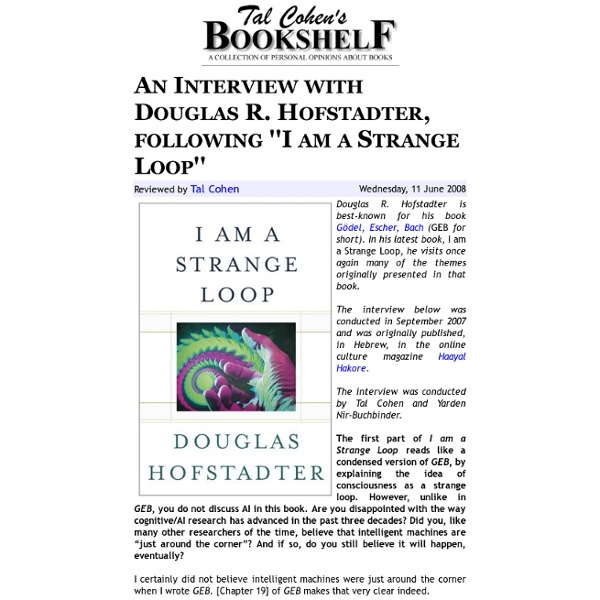I Am a Strange Loop
I Am a Strange Loop is a 2007 book by Douglas Hofstadter, examining in depth the concept of a strange loop to explain the sense of "I". The concept of a strange loop was originally developed in his 1979 book Gödel, Escher, Bach. Hofstadter had previously expressed disappointment with how Gödel, Escher, Bach, which won the Pulitzer Prize in 1980 for general nonfiction, was received. In the preface to its 20th-anniversary edition, Hofstadter laments that the book was perceived as a hodgepodge of neat things with no central theme. Hofstadter seeks to remedy this problem in I Am a Strange Loop by focusing and expounding on the central message of Gödel, Escher, Bach. As an exploration of the sense of "I", Hofstadter explores his own life, and those to whom he has been close.[4][5][6][7][8][9] See also[edit] References[edit] Jump up ^ Hofstadter, Douglas R. (1999).
RoboChamps
The Universe Magnified
This is one of the most beautiful infographics we've ever seen: a high resolution view of different levels of the universe. Our favorite parts are the jaw-dropping nebulae and then the point where you see the size of Pluto compared to Texas. Puts things into perspective. Copyright 2012. Embed this infographic on your site! <iframe width="600" height="388" scrolling="no" src=" frameborder="0" allowfullscreen></iframe><br />Copyright 2012. To get started with the infographic, click on one of the nine entry point images. The slider at the bottom of the screen lets you move around from bigger to smaller and smaller to bigger. And in between you see every day objects like animals and buildings and planets and stars. Have fun with this!
Boids
In 1986 I made a computer model of coordinated animal motion such as bird flocks and fish schools. It was based on three dimensional computational geometry of the sort normally used in computer animation or computer aided design. I called the generic simulated flocking creatures boids. Each boid has direct access to the whole scene's geometric description, but flocking requires that it reacts only to flockmates within a certain small neighborhood around itself. a boid's neighborhood A slightly more elaborate behavioral model was used in the early experiments. In cooperation with many coworkers at the Symbolics Graphics Division and Whitney / Demos Productions, we made an animated short featuring the boids model called Stanley and Stella in: Breaking the Ice. Since 1987 there have been many other applications of the boids model in the realm of behavioral animation. A significant property of life-like behavior is unpredictability over moderate time scales. Software Boids C++ Boids Buzzz!
Horticulture :: Greenhouse cultivation
1. Designs and classification of greenhouse 2. Orientation Of Greenhouse / Polyhouse 3. Components of green house 4. Plant growing structures/containers in green house production 5. 1. Greenhouses are frames of inflated structure covered with a transparent material in which crops are grown under controlled environment conditions. Classification of greenhouse based on suitability and cost a) Low cost or low tech greenhouse Low cost greenhouse is a simple structure constructed with locally available materials such as bamboo, timber etc. Carnation under low cost greenhouse b) Medium-tech greenhouse Greenhouse users prefers to have manually or semiautomatic control arrangement owing to minimum investment. c) Hi-tech greenhouse To overcome some of the difficulties in medium-tech greenhouse, a hi-tech greenhouse where the entire device, controlling the environment parameters, are supported to function automatically. Cost involved 1. 2. 3. Classification as per type of structure a. Top 2. 3.
Classification System | The Daffodil Society
What do those numbers and letters mean? What are all those number and letter combinations that appear in daffodil catalogues? The Daffodil Society follows the Royal Horticulture Society’s (RHS) daffodil classification system. In 1975, the RHS adopted a colour code system devised by American Dr. Tom Throckmorton. The letter refers to the colours of the daffodil as follows: W – White or WhitishG – GreenY – YellowP – PinkO – OrangeR – Red Daffodils are given a colour code to describe both the perianth (petal) colour and the cup colour. See the photo of Kaylee Ann below as an example: All daffodils are classified into one of thirteen divisions.
Perianth
Diagram showing the parts of a mature flower. In this example the Perianth is separated into a Calyx (sepals) and Corolla (petals) The perianth (sometimes called perigonium or perigon) is the non-reproductive part of the flower, and structure that forms an envelope surrounding the sexual organs. The term perianth is derived from the Greek peri, meaning around, and anthos, meaning flower, while perigonium is derived from gonos, meaning seed, i.e sexual organs. Flowering plants[edit] When the corolla consists of separate petals the term apotepalous is used, or polypetalous where there are many petals. Both sepals and petals may have stomata and veins, even if vestigial. Corona[edit] Flower of Narcissus showing an outer white corolla with a central yellow corona (paraperigonium) Ligulate floret, typical for flowers of some members of the family Asteraceae:A. ovaryB. pappusC. thecaD. liguleE. style with stamen Liverworts[edit] Bibliography[edit] Simpson, Michael G. (2011). External links[edit]
Definitions of Sciences and Studies
Sciences and Studies This list defines 633 sciences, arts and studies of various degrees of respectability and rarity, ranging from the common and esteemed (chemistry) to the obscure and quirky (peristerophily). Over the past century, the range and scope of scientific endeavours has expanded exponentially, so that practically any field of study has a name associated with it. Most of these terms end in 'ology', from the Greek logos, meaning 'word'. I hope you have found this site to be useful.



